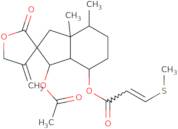
Información del producto
- 2-Propenoic acid, 3-(methylthio)-, 3′-(acetyloxy)decahydro-7′,7′a-dimethyl-4-methylene-2-oxospiro[furan-3(2H),2′-[2H]inden]-4′-yl ester, [2′R-[2′α,3′α,3′aα,4′β(Z),7′α,7′aα]]-
- Acrylic acid, 3-(methylthio)-, 7′-ester with 3′a,4,4′,5,5′,6′,7′,7′aβ-octahydro-1′β,7′α-dihydroxy-3′aβ,4′β-dimethyl-4-methylenespiro[furan-3(2H),2′-indan]-2-one acetate, (Z)-
- Spiro[furan-3(2H),2′-indan]-2-one, 3′a,4,4′,5,5′,6,7,7′aβ-octahydro-1′β,7′α-dihydroxy-3′aβ,4′β-dimethyl-4-methylene-, 1′-acetate 3-(methylthio)acrylate, (Z)-
- 2-Propenoic acid, 3-(methylthio)-, (2′R,3′R,3′aR,4′S,7′S,7′aR)-3′-(acetyloxy)decahydro-7′,7′a-dimethyl-4-methylene-2-oxospiro[furan-3(2H),2′-[2H]inden]-4′-yl ester, (2Z)-
Bakkenolide D is a sesquiterpene lactone that induces apoptosis in cancer cells. It has shown efficacy against kidney cancer, depression, and ischemia reperfusion injury. Bakkenolide D also has the potential to be used as an anti-infective agent and for the treatment of infectious diseases such as tuberculosis. Bakkenolide D induces apoptosis by binding to the mitochondrial membrane and activating caspase-8. This compound has been shown to have serum levels in animals that are similar to those observed in humans, suggesting that it may be effective for human use. Bakkenolide D can be synthesized from bakkenolides A and B, which are structurally related compounds found in plants of the Asteraceae family. These compounds were isolated from "Baccharis dracunculifolia" and characterized using LC-MS/MS methods.br>
Bakkenolides A and B can be obtained from
Propiedades químicas
Consulta técnica sobre: 3D-TAA45603 Bakkenolide D
Si desea solicitar un presupuesto o realizar un pedido, por favor añada los productos deseados a su carrito y solicite un presupuesto o pedido desde el carrito. Es más rápido, más barato, y podrá beneficiarse de los descuentos y las ventajas disponibles.





